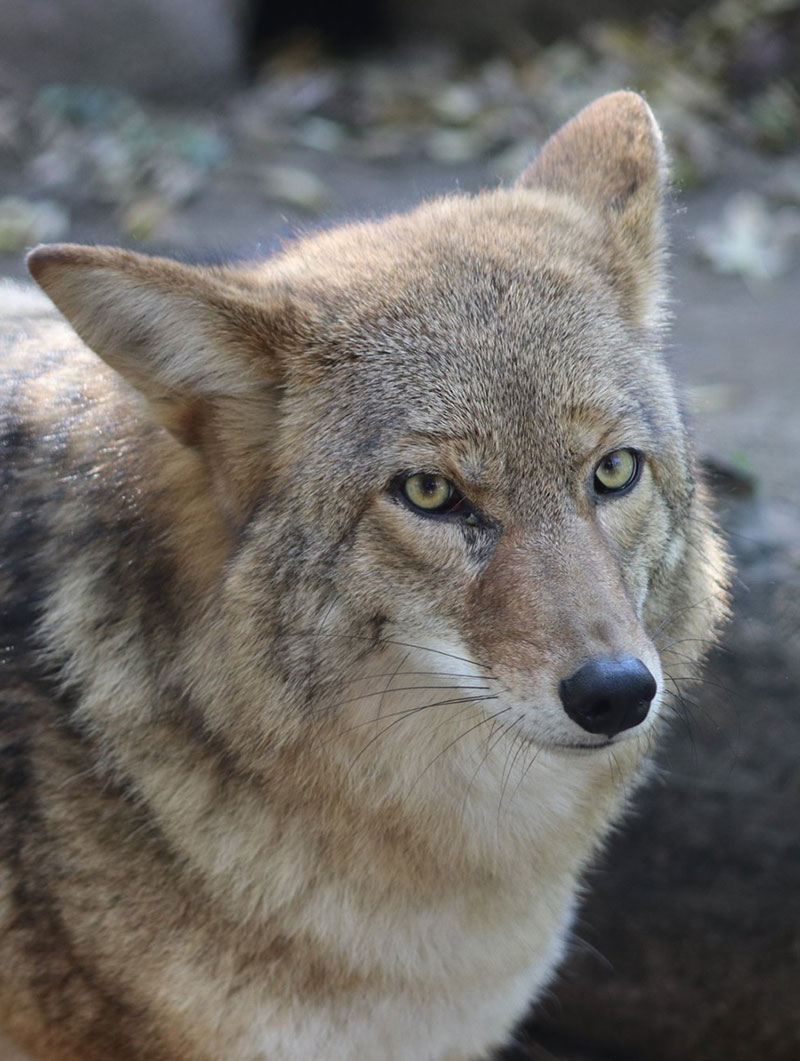Photo by Kmiecik Imagery
Coyote
Canis latrans
Description:
The coyote is a member of the canine family. Coyotes have a grey or reddish-grey coat with a buff belly, long buff-colored legs, and a bushy tail. They have bright yellow eyes and prominent ears.
Size:
Coyotes stand about 20” (50.8 cm) high at the shoulders and range between 3.5 and 5 feet (1.1-1.5 m) in length from nose to tail. The average weight of a coyote is 20 to 40 pounds (9.1-18.1 kg).
Adaptations:
- The thick fur of the coyote helps to keep it warm throughout the winter. Its color blends in with the environment, providing the coyote with excellent camouflage.
- Coyotes are cunning hunters that can run up to 40 miles per hour to catch their prey, often combining their efforts by hunting in groups of two or three.
- Coyotes have keen senses of smell and hearing, which also contribute to their success as predators.
Diet:
Coyotes eat rabbits, ground squirrels, mice, birds, carrion (dead animals) and a variety of other small animals. Their diet may also include fruit and other plant materials. At Cosley Zoo, the coyote is fed a commercial canine diet.
Reproduction:
Coyotes typically mate for life. Their typical den is a wide mouthed tunnel, terminating in an enlarged nesting area. Mating occurs in January or February and after a 60-to-63-day gestation period, the pups are born. Litter sizes range from one to 19 pups, with an average of six pups per litter. Both parents participate in feeding the pups regurgitated food. When the pups are about 35 days old, they can begin finding food for themselves. Pups typically leave the den when they are six to nine months old; however, some females do occasionally remain with the pack.
Shelter and space needs:
Coyotes can survive in a variety of climates and habitats. Although the coyote was originally native only to prairies and the arid west, it can now be found throughout the United States. By altering the landscape, humans have greatly decreased the populations of bears and wolves that were natural predators of the coyote. Because of this, the coyote has made its way into a greater range of urban areas than ever before.
Lifespan:
Coyotes have a high juvenile mortality rate and many die before becoming adults. However, coyotes that survive their first year can live eight to ten years in the wild.
Relationship with man:
The coyote has historically been reputed to kill and eat livestock, particularly sheep. Although certain individual coyotes have preyed on livestock, the bulk of the coyote’s diet consists of rodents and this problem is not as widespread as many believe it to be. In fact, coyotes are beneficial to agriculture as important predators of small animals such as mice that are considered agricultural pests.
Coyotes have proven to be adaptable when humans encroach on their territories, and as a result have learned to coexist with humans in urban or suburban areas. They rarely pose a threat to humans. People can help prevent coyotes from coming too close to their homes by securing garbage, refraining from feeding pets outdoors, keeping birdseed off the ground, and eliminating coyote-accessible water sources.
Fun Facts:
- The coyote is the most vocal member of the dog family. It makes several different types of vocalizations, including yelps, barks, and howls, which can be heard for miles.
- Coyotes have adapted very well to the presence of humans. While the populations of many animals are shrinking due to habitat loss, the coyote population is increasing in many parts of the country.
- The coyote is one of the few predators that will eat a porcupine. A coyote can kill a porcupine by flipping it over and grabbing it by the throat.
- The human is the coyote’s biggest predator. People cause the great majority of adult coyote deaths.






